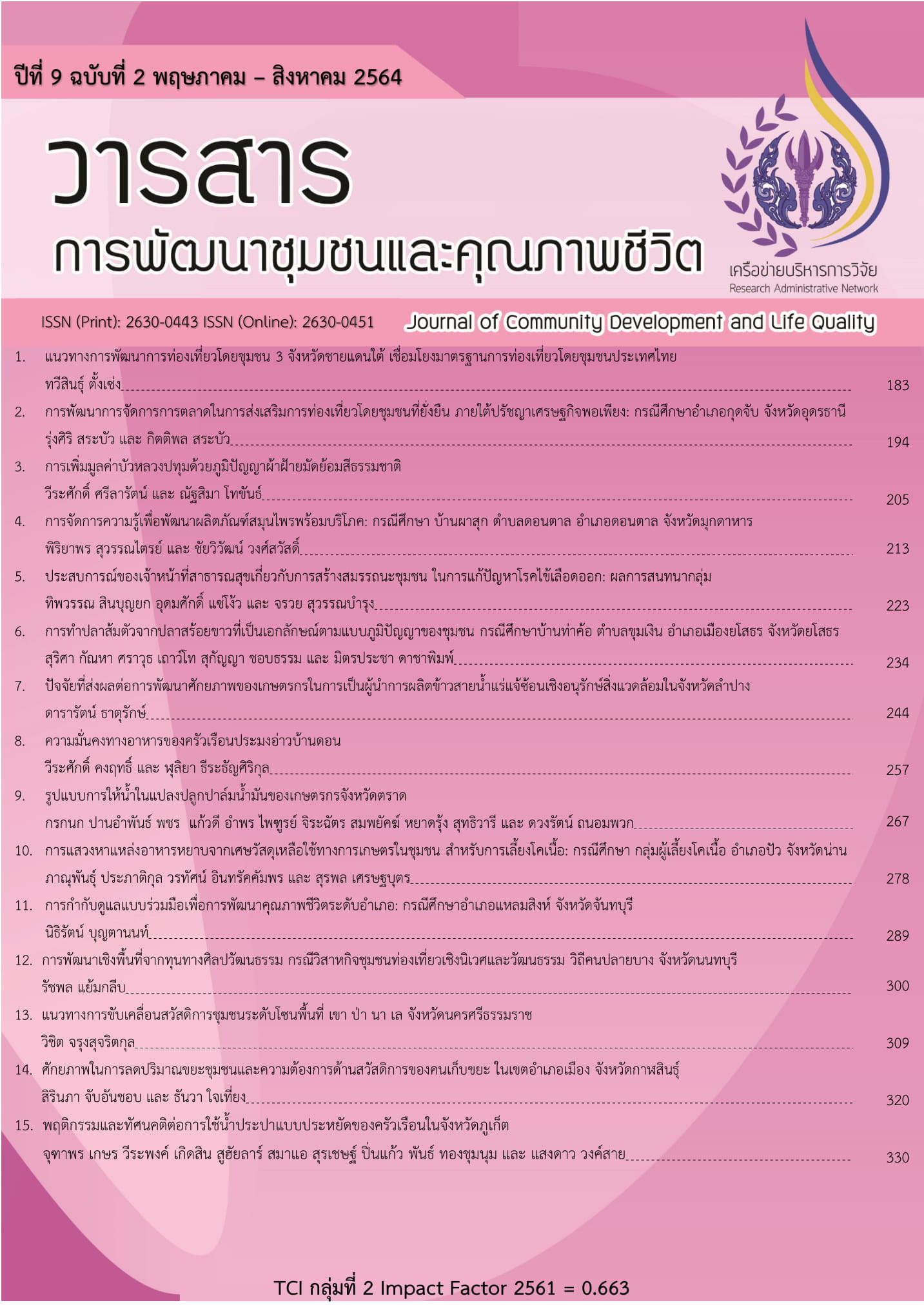Value Added of Sacred Lotus with Natural Tie-dyed Cotton Wisdom
Main Article Content
Abstract
This study increased value added of sacred lotus with natural tie-dyed cotton wisdom. This is an alternative option to reduce environmental problems, to promote career, and to conserve Thai culture. The results found that the dye extract from old lotus leaves, seed shells, and lotus petals (proportion 1:5) by boiling them for three hours until they turn brown with the maximum satisfaction (4.42 ± 0.08). The tie-dyed cotton techniques were tested by folding and tying, folding and tweaking, crumpling and tying, and then dying by hot dying method with extracted dye from lotus leaves, seed shells, and lotus petals for one hour. We found that all techniques were satisfied by using questionnaire method (n=100). The maximum satisfaction was the tie-dyed cotton by crumpled and dyed technique from seed shell extract dye with the highest satisfaction score, followed by the lotus leaves extract dye and lotus petals dye, respectively. The tie-dyed cotton from the sacred lotus extract dye is not too flashy and the exquisite patterns attract the eyes; therefore, it is suitable dyes for making clothes and artificial flower. The natural dye can replace synthetic dye and the dye method is not complicated so it is suitable for promoting community businesses.
Article Details
The Editorial Board claims a right to review and correct all articles submitted for publishing
References
Akinjogunla, O.J., A.A. Adegoke, I.P. Udokang and B.C. Adebayo-Tayo. 2009. Antimicrobial potential of Nymphaea lotus (Nymphaeaceae) against wound pathogens. Journal Medicinal Plants Research 3(3): 138-141.
Chochai, P. 2008. The development of the natural dyes dyeing of cotton yams: case study the dyeing with dyes from coconut bark and pterocarpus bark of the community in Tumbon Nabokham, Kamphaengphet province. The Golden Teak: Humanity and Social Science 14(2): 26-45. (in Thai)
Chuthaputti, A. 2003. Pharmacological effect of lotus. Journal of Thai Traditional and Alternative Medicine 1(1): 61-63. (in Thai)
Hongpakdee, P. 2013. Sacred lotus: Potential of Thai flower through ASEAN market. Khon Kean Agricultural Journal 41(3): 213-220. (in Thai)
Imsabai, W., S. Ketsa and W.G. van Doorn. 2010. Role of ethylene in the lack of floral opening and in petal blackening of cut lotus (Nelumbo nucifera) flowers. Postharvest Biology and Technology 58(1): 57-64.
Jitphusa, A. 2017. Optimization of time and rations of mixed fixing agents for dyeing of 100% cotton using instant coffee. RMUTSB Academic Journal 5(2): 136-145. (in Thai)
Kumtabtim, U. and R. Hongkrengkai. 2019. Metal and dyes removal from waste water using lotus leaves adsorbent. Science and Technology RMUTT Journal 9(2): 39-53. (in Thai)
La-ongsri, W., C. Trisonthi and H. Balslev. 2009. Management and use of Nelumbo nucifera Gaertn. in Thai wetlands. Wetlands Ecology and Management 17(4): 279-289.
Mehta, N.R., E.P. Patel, P.V. Patani and B. Shah. 2013. Nelumbo nucifera (Lotus): A review on ethanobotany, phytochemistry and pharmacology. Indian Journal of Pharmaceutical and Biological Research 1(4): 152-167.
Ngampipat, C. 2019. The design of tie-dye techniques pattern and dyeing with natural dyes: A case study of high school students at Mathayom Puranawas school, Taweewattana district, Bangkok province. Journal of Fine Arts Research and Applied Arts 6(1): 246-265. (in Thai)
Singchai, B., N. Trakulpukdee and S. Thonglim. 2017. Essential oil from Nelumbo nucifera Stamen. Thai Journal of Science and Technology 25(1): 26-34. (in Thai)
Sittinoppan, P., P. Kantuptim and P. Panbumrung. 2014. The development of tie-dyed prototype with natural dyes. Journal of Western Rajabath Universities 9(1): 81-89. (in Thai)
Subzar, A.S. 2014. Ethno-medicinal use and pharmacological activities of lotus (Nelumbo nucifera). Journal of Medicinal Plants Studies 2(6): 42-46.
Sukonthamanee, P. 2017. Color of Flora. Silpakorn University Journal 47(3): 183-202. (in Thai)
Thanikkun, T., S. Samuhasaneetoo and P. Penroj. 2015. Extraction conditions on properties of bioactive compounds of lotus leaves extract (Nelumbo nucifera Gaertn.). Naresuan University Journal: Science and Technology 23(2): 34-42. (in Thai)


